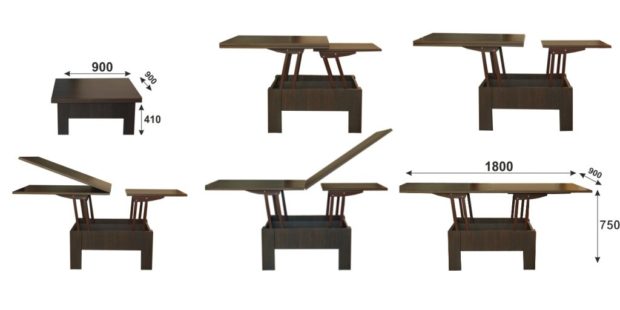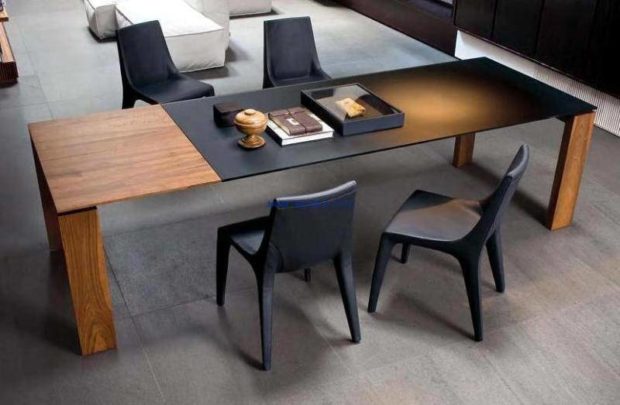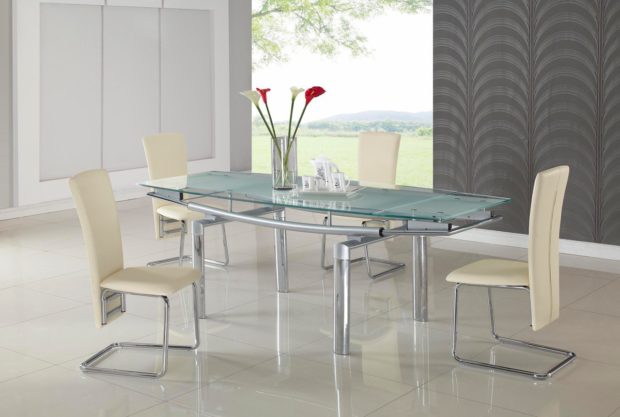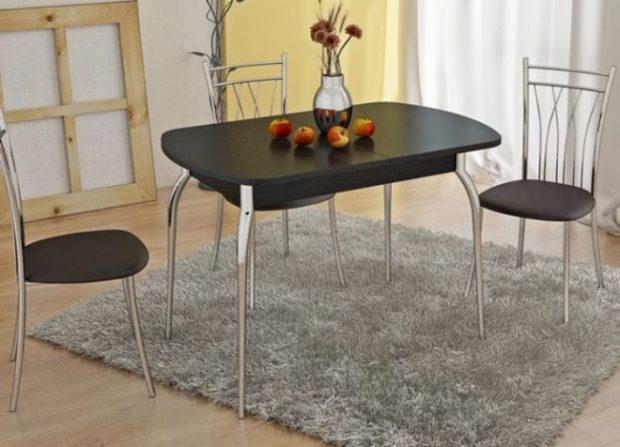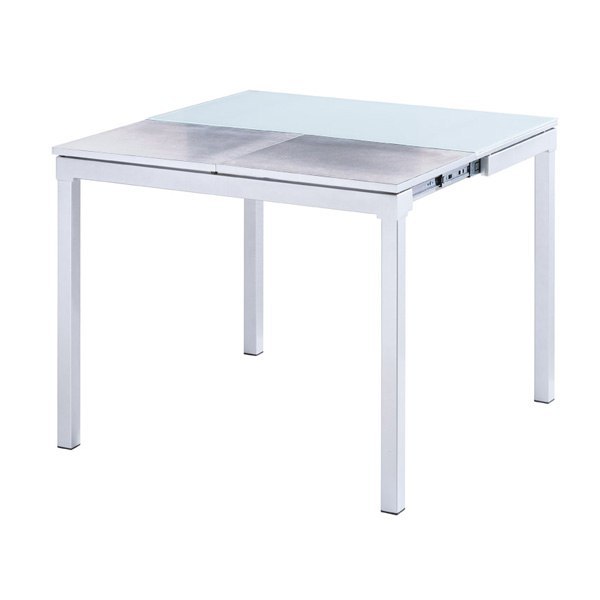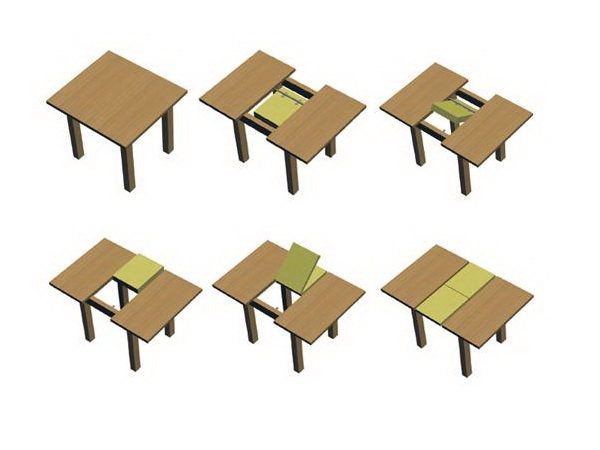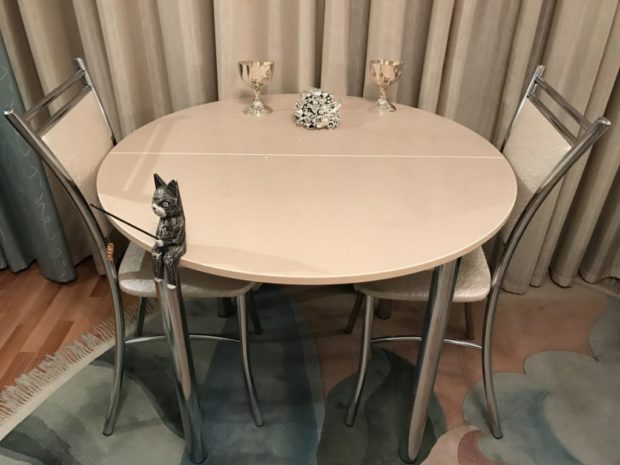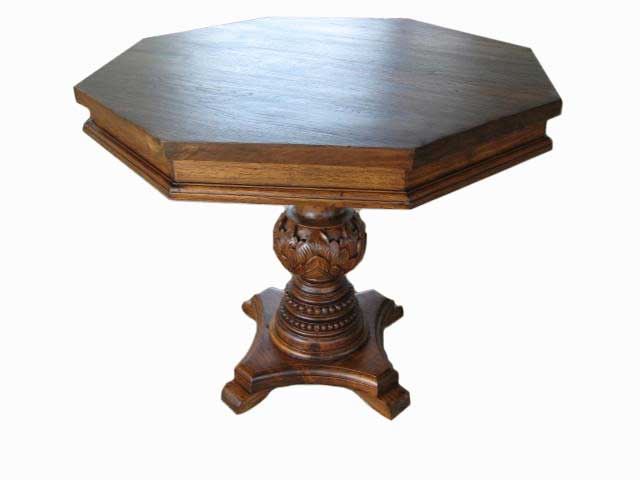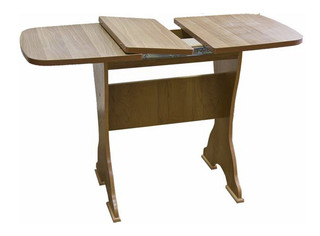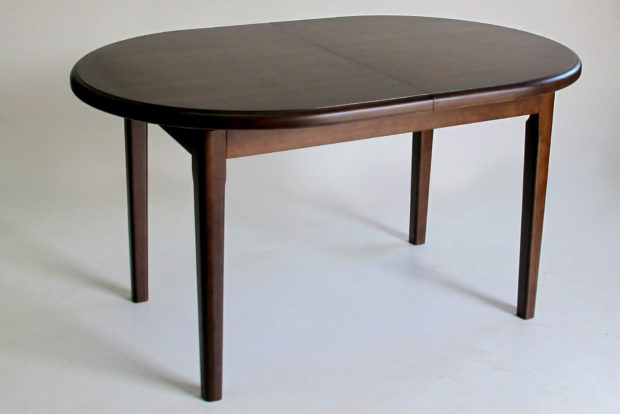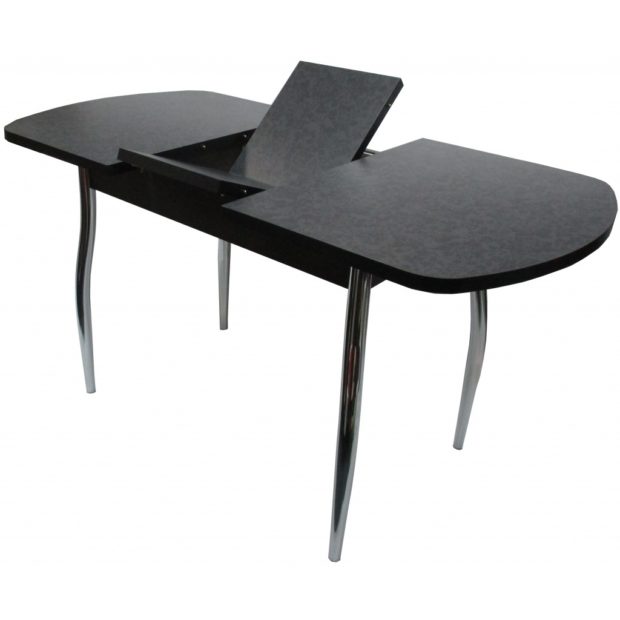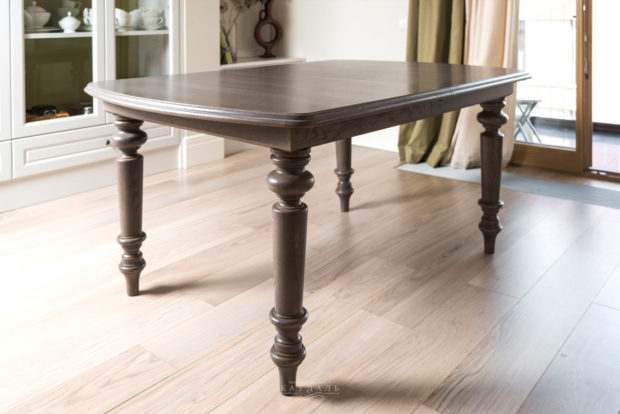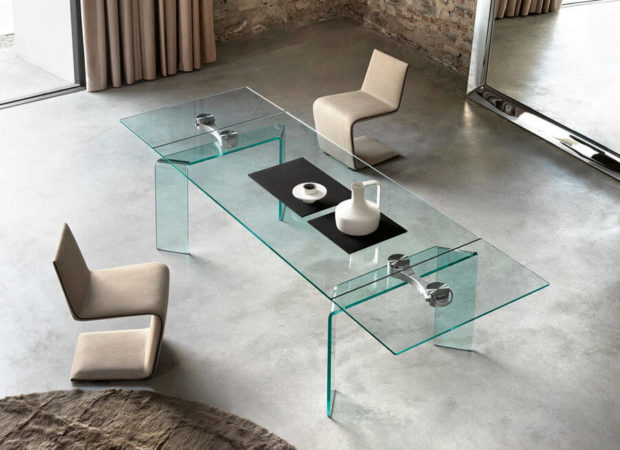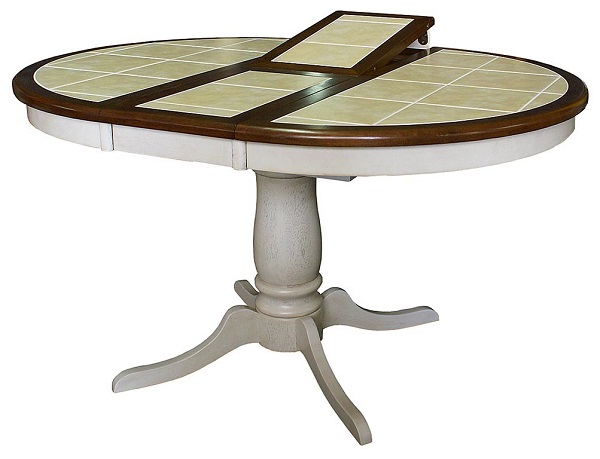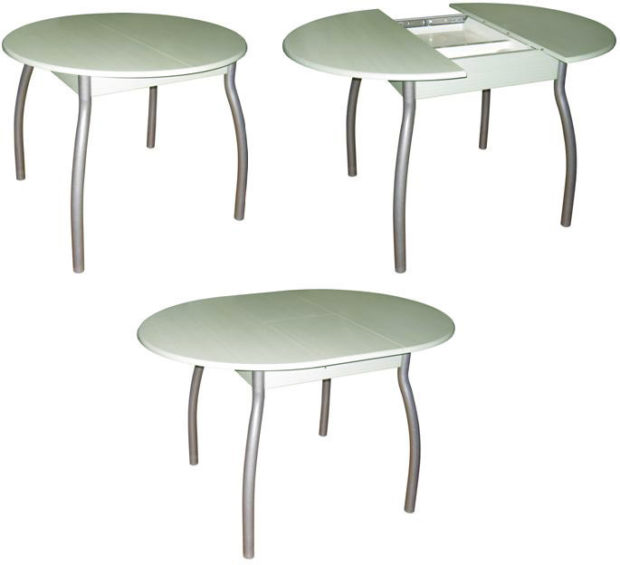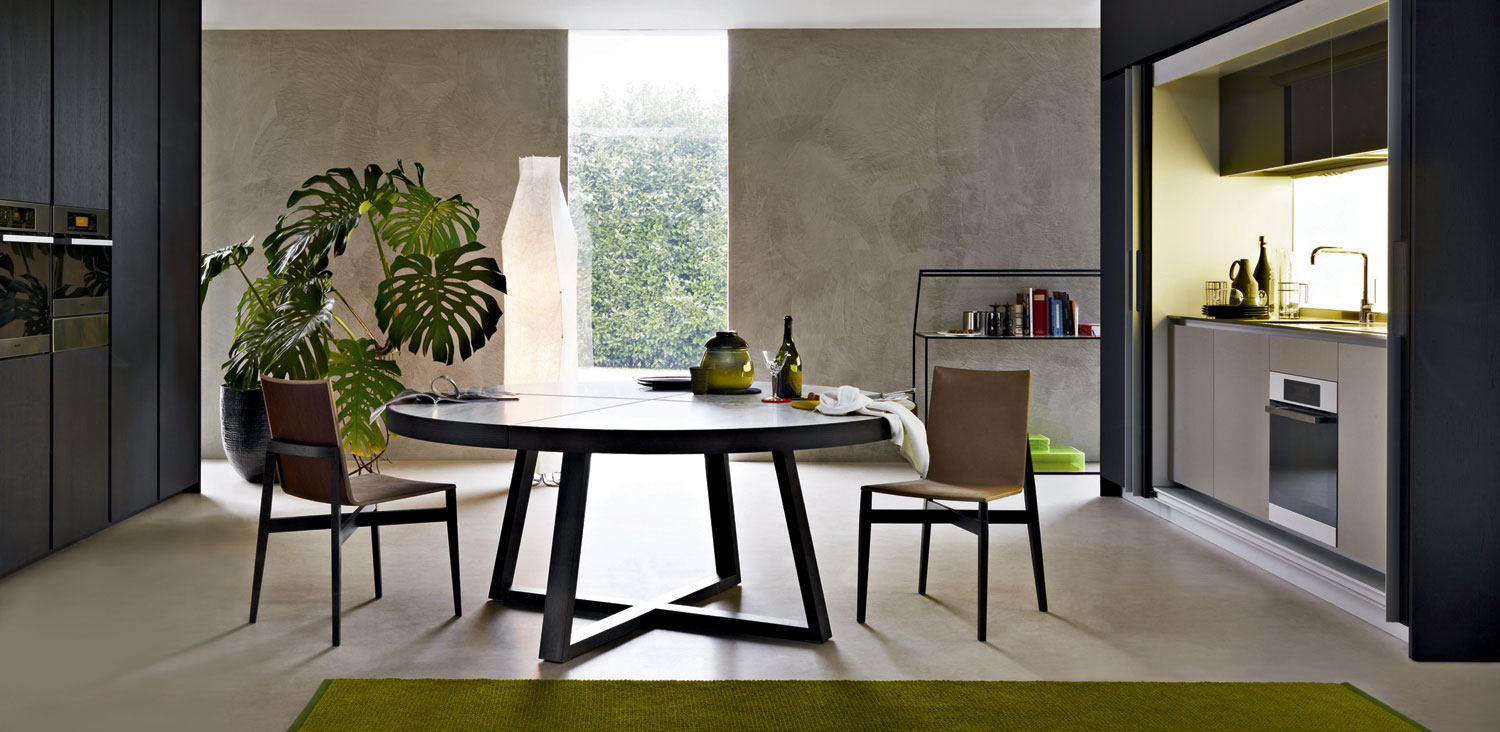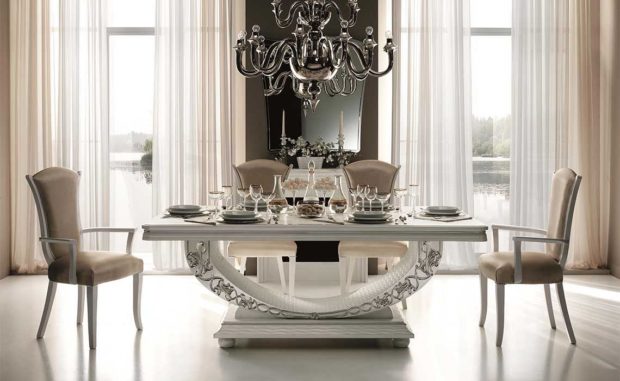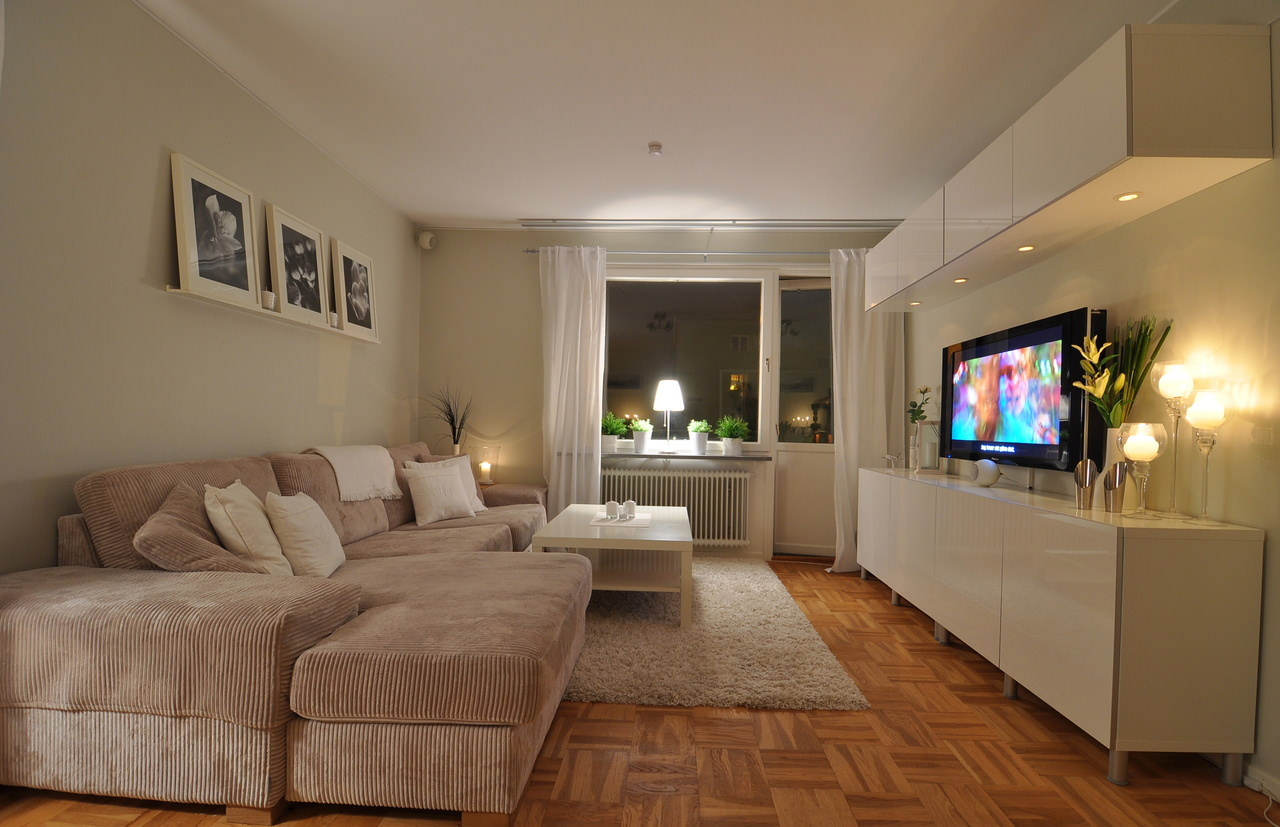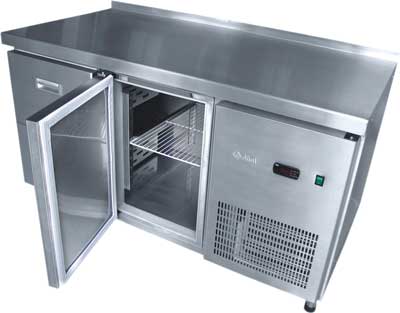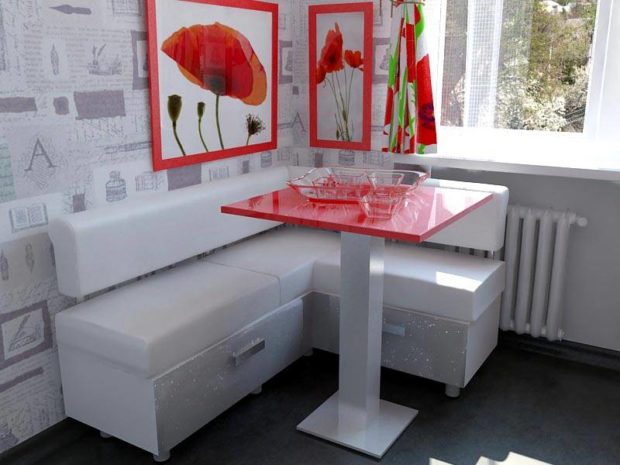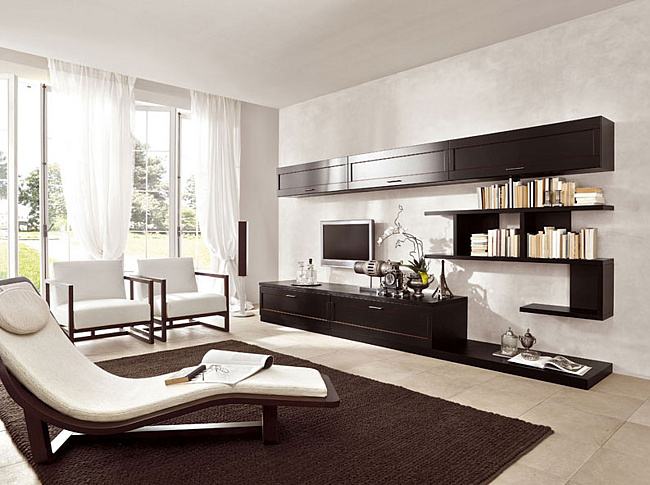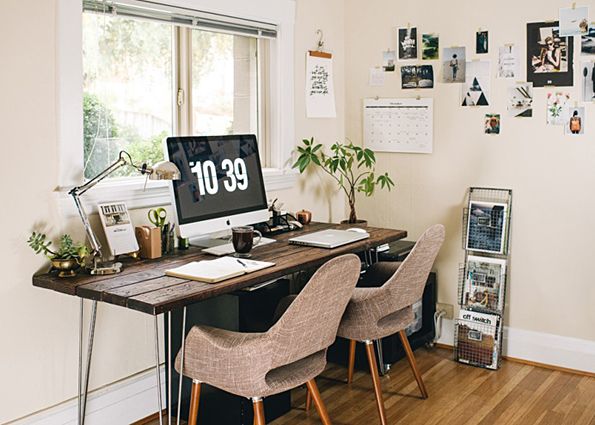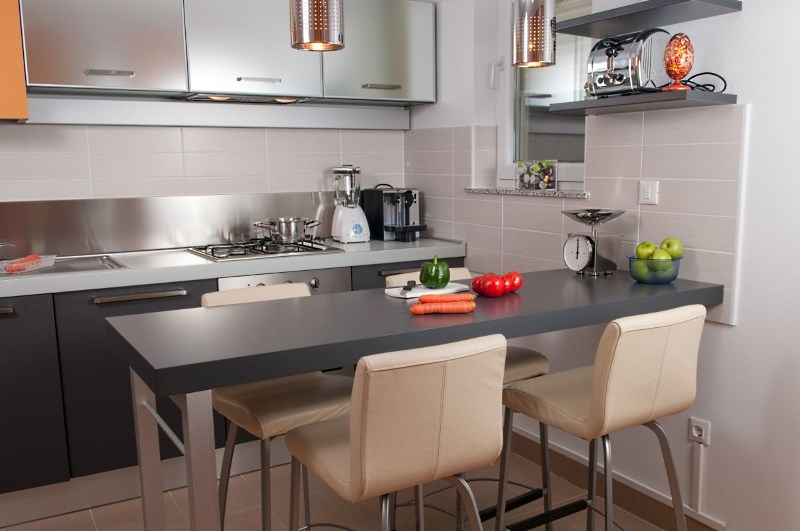7 tips for choosing sliding tables: shape, material, layout mechanism
The table is an integral element of the kitchen, and sometimes the living room. It is without this piece of furniture that it will be difficult to imagine any feast. So, its size should be sufficient for comfortable accommodation of all family members and guests. The view that the area of premises in ordinary apartments does not differ in particular spaciousness, fitting a table of sufficient length and width can be problematic. A reasonable alternative and real salvation in such cases will be the acquisition of transformer tables. This modern solution will allow not only to significantly save precious space, but also to pick up a piece of furniture that fits perfectly into the interior. In this article we will give 7 tips for choosing sliding tables, consider the most popular forms of countertops, material of manufacture and typical layout mechanisms. We will tell you what you need to pay attention to when choosing and how to properly operate folding structures in order to extend their service life.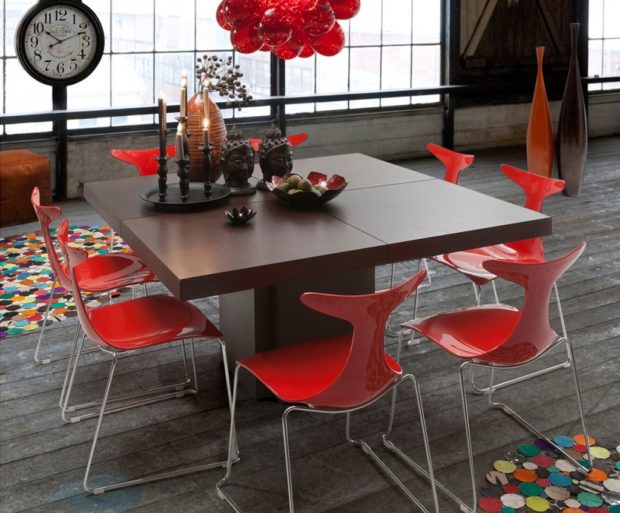
Before you make a purchase
Before you go looking for your perfect table, you must understand that really high-quality furniture can serve more than one year. If you are not one of those who are used to changing the interior every couple of years, and at the same time most of the furniture, we recommend that you carefully consider the choice.
- First of all, you need to decide on the necessary dimensions. What does it mean the dimensions of the table when unfolded. For more rational use countertops It is recommended to place guests around the entire perimeter of the table, which means that it must be moved away from the wall to the center of the room. For free movement, a minimum of 70-80 cm should remain on all sides;
- Please note that on size selection the table also affects the area of the room. A sliding table can be not only a kitchen, but also a coffee table. The latter when folded has compact dimensions, and if necessary, its central part rises up with the help of special mechanisms and is laid out to the sides. Thus, it increases not only in length, but also in height, and turns into a full-fledged table. Therefore, remember how many guests you take on average during the holidays and whether you can stay in the living room. This is especially true for a small family, which is quite enough for a small dining table;

- For comfortable use, at least 60 cm of worktops are required per person and 45 cm in width. The picture below is optimal seating pattern guests and the required size depending on the number of people;

- Given the average growth rate of an adult, the tables have a standard height of 75 cm. However, given the individual needs, it is possible to make tables with a lower or higher height;
- Pay attention to matching appearance products to the general style of the room. For example, if the interior is made in one of modern styleswhere minimalism and the use of modern materials are preferred, the wooden table in classic style will stand out sharply and seem inappropriate;
- Also, immediately ask the store about the possibility of selection set of chairs to the model you like. Many manufacturers immediately offer ready-made dining groups. This is the most profitable option both in terms of design and financially. After buying a custom product, you may have difficulty choosing chairs or soft corner.

10 advantages and 1 disadvantage of transforming tables
Sliding tables can really be called the best option for use in cramped conditions. And in modern interiors, where special attention is paid to functionality and ergonomics, transform furniture is used most often. In addition, during operation, you will definitely find several more the benefits similar designs:
- Aesthetics. The design of sliding tables is made at the highest level and allows you to purchase not only a piece of furniture, but a real decoration of any interior;
- A clear layout mechanism that you will learn on an intuitive level. In order to quickly figure out how to handle the table, you do not need to study the instructions for a long and painful;

- Ease of use. Even the most complex layout mechanisms are designed for minimal physical effort. Therefore, both a fragile girl and a teenager can cope with the task;
- Significant increase in size. Some models of sliding tables are able to increase in length threefold, or even fourfold. Large models when unfolded can reach a length of about 4 meters;
- Regulation of several parameters simultaneously. Many modern models have the ability to change not only the length of the countertop, but also its height. This makes it possible to maximize table settings to fit your own needs;

- Increased comfort. The configuration of modern models is thought out in such a way that no matter what layout method you choose, you will always have enough legroom. Such important little things undoubtedly significantly increase usability;
- A variety of materials. You can find tables made from traditional materials, such as chipboard, MDF or wood, as well as completely atypical. For example, expensive designs complement the elegant countertops made of stone or ceramic tiles. This makes it possible not only to choose a model in full accordance with a kitchen set, an apron or other pieces of furniture, but also to choose from a different price segment. Thus, even on the most modest budget, there is an optimal offer;

- A variety of shapes and colors. It also makes it possible to simplify the selection;
- High reliability and stability. Despite the fact that the design consists of several elements and a guiding mechanism, in the unfolded form it is not inferior to conventional solid models in terms of strength. Extendable tables can also withstand significant loads;
- Subject to proper and careful handling, the service life of the transformer tables can reach 10-15 years. Agree, these are very impressive numbers, given the design features.
TO disadvantages only high cost can be attributed. However, with so many advantages and such a long service life, we can say that it is fully justified.
Types of sliding mechanisms
Transformer tables can have various types of layout mechanisms. The most durable and most common are the following options.
Extendable table with drawer and pull-out center
Tsarga — this is massive base or frame to which the countertop is attached. One of the most popular and simple designs of tables with manual layout is a model with a retractable central part.In the assembled form, in the center of the countertop there is a docking seam, and under the countertop itself there is a compartment for placing the sliding part. In order to lay out such a table, it is necessary to push both halves of the countertop to the sides, and then remove the central part and insert it into the grooves. Then push back the side halves to a characteristic click. This means that all parts of the structure are fixed in the correct and stationary position. With this layout method, the length of the table can increase by 1/3 or 1/2 of the length when folded.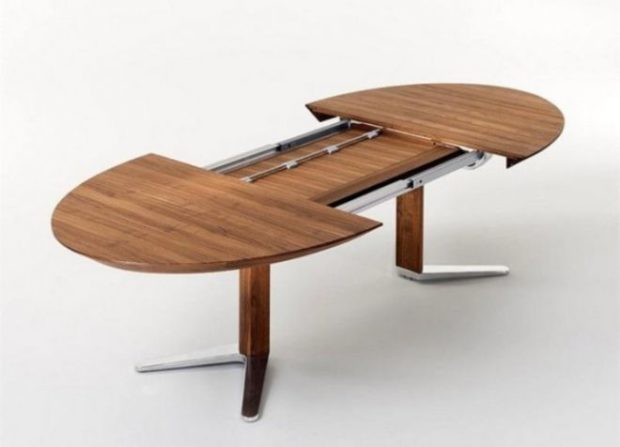
Similar models have the following advantages:
- It is worth noting that this is one of the most durable, durable and reliable designs;
- Most tables are made in this way not just like that, but because this solution is really time-tested. Please note that the old Soviet tables, which were able to fold out, had just such a frame.
- Both assembled and disassembled, they provide a high degree of stability and can withstand heavy loads. Most often, the material of manufacture is natural wood, and the guides are made of metal.
Disadvantages Such tables can be called the following points:
- Massive appearance. Depending on the style of the interior, this can be both an advantage and a disadvantage. After all, you can’t call such a model airy and weightless;
- The inconvenience associated with the fact that in most cases when sitting you will rest your feet against the tsar.
Extendable table with drawer and swivel center
This type of design differs from the previous one only in the configuration of the middle extension part and in the way of its installation. Models with a rotatable central part considered more modern and functional. This is explained by the fact that the increase in the dining area is provided by two inserts in the center, which are hidden in the underframe. To decompose such a mechanism, it is necessary:
- Push the sides to the sides by pulling the edges;
- Under the countertop you will see two rotary inserts;
- They need to be rotated 180 degrees, laid out and slide the sides towards them.
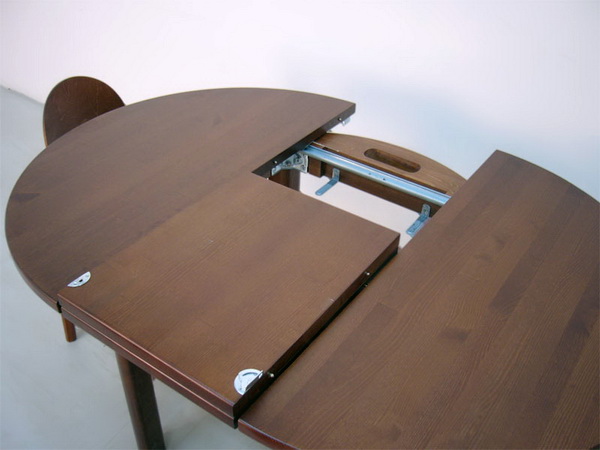 After the transformation in the center of the table there will be several joining seams. Useful surface area in such a simple way can increase by 30-40% of the original length. Regarding the complexity of handling such a design, we can say that the swivel mechanism is more convenient than a retractable one.
After the transformation in the center of the table there will be several joining seams. Useful surface area in such a simple way can increase by 30-40% of the original length. Regarding the complexity of handling such a design, we can say that the swivel mechanism is more convenient than a retractable one.
Double table extension table
it simplest in circulation and a primitive execution mechanism of the layout. When folded, this is a regular small table with no visible joints on the countertop, since it has a double one. Thus, the feeling is that the thickness of the countertops is very large. Such a construction is decomposed very simply:
- It is necessary to remove the top of the countertop;
- Under it you will see the same, but with a seam in the middle;
- It is necessary to pull the sides in different directions;
- In the middle, a frame and free space is formed, the size of which is exactly equal to the first layer. Here you need to return the top of the table, shot before this.
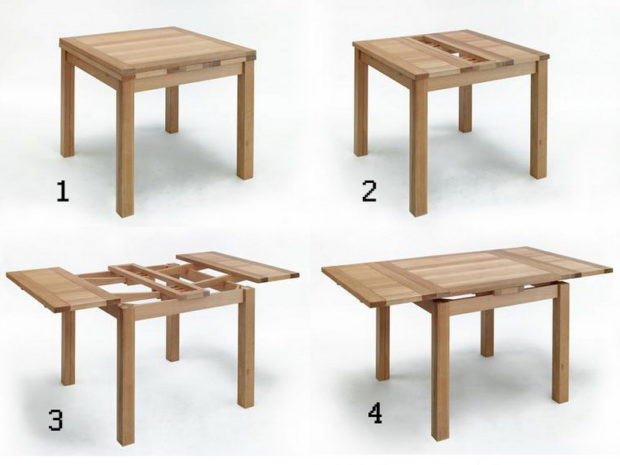 Advantage such a design is to increase the area exactly twice the original size. However, there are disadvantages:
Advantage such a design is to increase the area exactly twice the original size. However, there are disadvantages:
- Depending on the material of manufacture and size, the countertop, which must be completely removed for layout, can have an impressive weight. Therefore, the help of a second person may be required;
- When unfolded, the edges of the table have virtually no support or support. This makes the design less reliable and introduces restrictions on the placement of objects on the table. Heavy is recommended to be placed closer to the edge.
Extendable table with movable legs
it a completely new mechanism which is radically different from all of the above.If in previous cases only the countertop was involved in the transformation process, now I’m also taking part in the layout. There is two modifications a similar mechanism - sliding and folding. When folded, the table has no distinguishing features from the usual. To decompose sliding construction needed:
- Hold the tsar from below and pull on yourself;
- It will corrode, and you will see an additional countertop;
- In some models it needs to be pulled out and turned, and in some it is enough to simply push it out.
At the same time, the surface of the countertop increases by 30-50% without special effort.
Folding the modification looks when folded looks like a regular table with a two-layer countertop. The mechanism works as follows:
- Pull on yourself, holding the king;
- After the legs have completely left, you need to lay out the countertop, like a book;
- When unfolded, it must be moved to the center of the table.
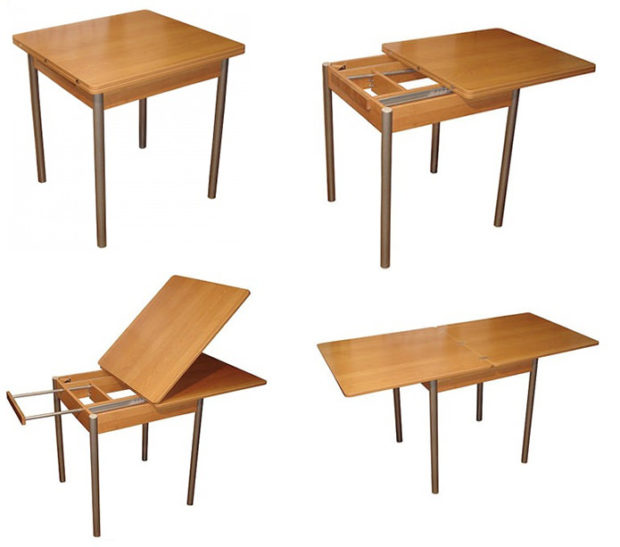 As a result, you will get a countertop with an area much larger than the size of the assembled table. Sometimes, to facilitate the layout process, the design equipped with additional lifting gear which helps push the countertop with the least effort. Such tables can already be attributed to structures with a semi-automatic layout. However, they have one significant disadvantage:
As a result, you will get a countertop with an area much larger than the size of the assembled table. Sometimes, to facilitate the layout process, the design equipped with additional lifting gear which helps push the countertop with the least effort. Such tables can already be attributed to structures with a semi-automatic layout. However, they have one significant disadvantage:
- The smallest indicator of durability in comparison with other mechanisms;
- When unfolded, the countertop itself has a not very aesthetic appearance, since the border of the transition of the main element and the additional one is clearly visible.
Gearless gear
A distinctive feature of such tables is the lack of massive support for countertops. This allows you to visually make the design more graceful and not so bulky that sometimes is simply necessary. Often, manufacturers use tempered glass as the tabletop material, which makes the table even “lighter” and gives it a modern look. Such tables perfectly complement the interiors in the style of minimalism, loft or hi-tech. The sliding mechanism is a metal guides which are mounted under the countertop. Of course, they will be visible through transparent glass, but this does not spoil the appearance of the product. On the contrary, it makes it even more interesting.  Glassless table topless table possesses high aesthetic qualities and beside other advantages:
Glassless table topless table possesses high aesthetic qualities and beside other advantages:
- Useful surface area can increase by 30 to 50% of the original, and sometimes twice as much;
- The mechanism is very smooth and easy to move, the absence of all kinds of jamming and other difficulties. This makes the layout process very simple and does not require physical effort.
Among disadvantages designs with the absence of the drawer can be identified:
- Relatively less strength. And this also applies to the guides themselves, which are inferior to the guides from knocked down wood, and the countertop itself, if we are talking about such a material as glass;
- If, after layout, the length of the countertop increases two or more times, it is necessary to use an additional support;
- The cost of such tables can far exceed the cost of tables with a drawer frame. It depends directly on what accessories are used and what material was chosen for the countertop. The price of models from world famous manufacturers can reach 1000-3000 €.
Countertop Tips
On the one hand, the variety of forms offered can really complicate the choice, but on the other hand, it allows you to choose the optimal model specifically for your room. The shape of the countertop should be in harmony with the overall design of the room and be selected depending on its area. It is also necessary to consider how many people will most often sit at the table. Let's consider in more detail all possible options:
- Square the form.Such tables can have both quite compact dimensions in assembled form, and quite overall. The first option will be optimal for placement in a small kitchen. Larger models organically look in spacious dining rooms or in living rooms, combined with the kitchen. The average standard sizes of a square countertop allow you to simultaneously fit 4 people in assembled form and from 6 to 8 in unfolded. This is more than enough for a small family. TO disadvantages include a reduced level of comfort and a limit on the number of seats. This is due to the presence of legs from each corner, which makes it possible to fully place only one person from the end of the table;

- Rectangular the countertop is considered the optimal solution and fits perfectly into both modern and classic interior styles. Such tables are relevant for use both in spacious and in small rooms. In the assembled state, they can fit up to 6 people, and when unfolded - all 12, which is very convenient for large companies.

- Round tables are an original and non-standard choice. They harmoniously look both in small rooms, and in spacious. Them feature lies in the fact that they occupy much less space than square or rectangular in the absence of angles. This fact makes moving around the room easier. Tables with a round shape are recommended for families with small children. This will reduce the possibility of injury from an accidental impact on an acute angle to a minimum. The standard diameter of a round countertop is 90-110 cm when assembled. In the unfolded state, it either turns into an oval, or increases the usable area by 30-50%;

- Oval tables are also considered more compact and safe. In terms of capacity, they are practically not inferior to rectangular models, which makes them very popular, and still take up less space. We can say that such a form is intermediate between a circle and a rectangle;

- Octagonal form is not found in every manufacturer. Such an unusual solution, despite the presence of a large number of angles, is very roomy and convenient. This form clearly defines the number of seats at the table and provides a high level of comfort. And thanks to the extraordinary appearance, the octagonal table can become a real decoration and highlight of the interior.

The choice of material
Like other pieces of furniture, sliding tables can be made from a variety of materials. Naturally, this affects the cost of the product, which makes it possible to choose a model for a different budget. Material selection directly affects strength and durability, therefore, the choice must be conscious and reasoned. Today, manufacturers offer the following options, which we will list in order of increasing cost:
- Chipboard - refers to the most accessible materials. Accordingly, the strength of the product from it will be the least, but this does not mean that you should not even consider such an option. With proper care and operation, a chipboard table can last for more than one year. Pay attention to the thickness of the product. Better models are made of laminated sheets with a thickness of at least 16 - 18mm. Also, special attention should be paid to the quality of the processing of the ends, which are most often pasted over with a decorative edge about 1 mm thick. It protects the material from moisture and prevents its swelling. The edge can be matched exactly to the tone of the chipboard sheet, or it can be several tones darker or lighter and set off the main color. The laminated surface of the material can be of very different tones, imitate the surface of natural wood and have the appropriate texture, repeat the color of natural stone and other materials;

- MDF - more durable material than chipboard due to the use of fine fractions in the manufacture of wood chips and sintering of sheets under high pressure. MDF refers to moisture resistant materials, which greatly facilitates the care of the finished product. In terms of strength and cost, it is superior to chipboard, but also inferior to natural wood. The surface can have a variety of textures and colors, so the models of tables made of MDF differ in aesthetic appearance;

- Plastic - A very convenient material for making lunch words. He is not afraid of moisture, which allows you to wipe the product with a damp sponge or set tables near the sink. Designers often prefer this material to the rest because of its flexibility and ability to make objects of the most unimaginable forms. Plastic tables will be a great addition to modern interiors, such as high-tech. Despite its lightness, the structures have sufficient strength and impact resistance. The only thing that plastic does not like is high temperatures and mechanical stresses. In this regard, it is not recommended to remove dirt from the surface with the help of hard sponges, place hot dishes without supports or set tables near ovens;

- Natural wood - This material has always been considered one of the best for the manufacture of furniture, and tables are no exception. Natural wood has many advantages - increased strength, durability, reliability, natural beauty. Wooden products do not need additional decorative decoration; they already look expensive and presentable. In addition, it is an environmentally friendly material that does not cause allergic reactions. Wood can be used both for the manufacture of all structural elements, and separately for the frame or countertop. Be sure to make sure that the surface is well polished, impregnated with a special solution and varnished;

- Glass mainly used for the manufacture of countertops. It is very rare, but still possible to meet models made entirely of glass. They look really impressive, but their cost is at an appropriate level. The most common combination is a glass top + metal or wooden frame. At production not ordinary glass is used, but thicker, tempered. This virtually eliminates the possibility of minor scratches. But if you hit the end of the countertop, you may well chop a small fragment. Glass is not afraid of temperature changes, so without consequences you can put hot dishes on its surface. With careful handling, glass products can last for many years and not lose their original attractiveness;

- Metal - strong and reliable material, which in most cases is used to make the frame and guides. The most commonly used aluminum or steel, which greatly facilitates the weight of the entire structure. It also increases the resistance of the product to the effects of negative external factors - corrosion, moisture, mold, absorption of unpleasant odors. Tables made entirely of metal are rare. They look appropriate only in ultramodern interiors. Most often, countertops are made of other materials - glass, wood, stone;

- Natural or fake diamond It is mainly used for decorative purposes for finishing or manufacturing countertops. Such tables are very heavy and high cost. Artificial stone is lighter and not as porous as natural. But in both cases you should avoid hitting the surface. This will lead to the formation of cracks and chips.

Features of the choice of fittings
From the quality of the fittings will depend on Not only durability sliding tables, but also the convenience of their operation.High-quality guides can provide an easy and smooth movement of the mechanism, the absence of jamming, backlash and distortions, which can lead to premature failure. In the case of savings, and the acquisition of more affordable fittings, you run the risk of spending additional funds annually on the repair of individual elements. Therefore, pay attention to the following points:
- The material of the guides must be reliable and durable. It is better if it is metal in combination with plastic;
- Be sure to try the mechanism in action. Make sure that the layout process does not require excessive physical effort;
- Manufacturers who guarantee the factory quality of their products often mark them accordingly. It can be a combination of letters and numbers, a store number or a company logo. Carefully inspect individual elements for similar characters;
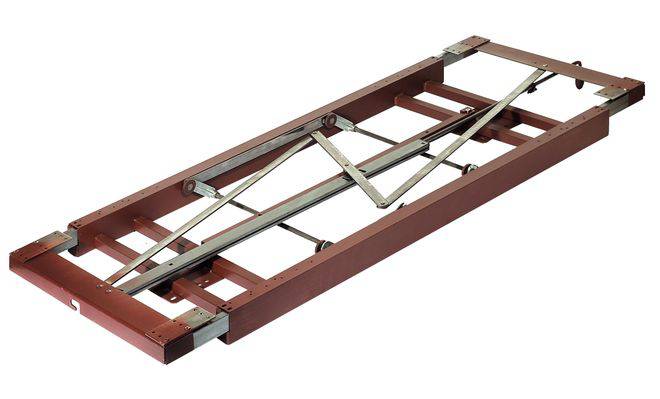 In a word, hardware is that element of sliding structures on which it is not recommended to save.
In a word, hardware is that element of sliding structures on which it is not recommended to save.
How to operate sliding tables
Each model of a sliding table is obligatory will have instructions where are the operating rules. Compliance with them will extend the life of the product. Depending on the material of manufacture, there are also general recommendations:
- Wooden tables should be wiped using special polishes and only with a soft cloth. It is forbidden to use aggressive cleaning agents, hard metal sponges, and to expose the surface to prolonged exposure to moisture;
- Glass tables requires the use of special detergents, which are listed in the instructions. End bumps and contact with dishes just removed from the fire are prohibited;

- Countertops made of natural or artificial stone should be protected from shock. Wipe the surface with a soft cloth only. Do not use stiff scrapers to remove stains.
If all the requirements are met, sliding tables can justify their high cost with a long service life and excellent appearance.

